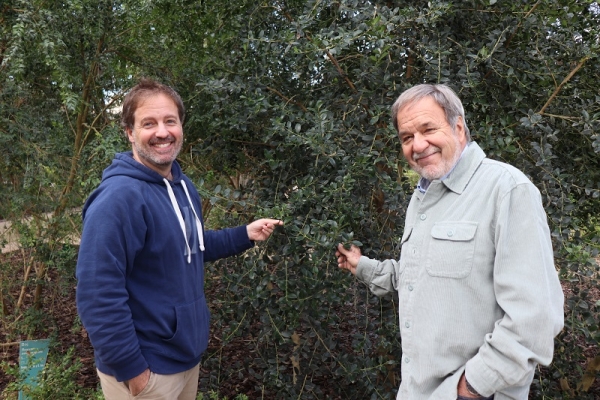The Balearic boxwood (Buxus balearica) a species that in recent years has reduced its extension and that is found on the Iberian Peninsula in very arid areas, such as Malaga, Granada and Almeria, has a special capacity: it condenses fog moisture of on its leaves, causing the drops to fall to the ground, thereby reaching basins and aquifers. In this way, the Balearic boxwood can be of use against drought by providing an extra supply of water. However, future climate change scenarios calculated until the end of the 21st century warn of the disappearance of the Balearic boxwood in the southeast of the peninsula, so it is necessary to implement conservation programs averting these scenarios.
This is what a research team at the University of Cordoba's Department of Forestry Engineering states in an article published in the journal Diversity, as does a doctoral thesis by UCO researcher Yalberiy Labarca. In the three scenarios they have calculated ―for 2040, 2050 and 2100― the Balearic boxwood tends to disappear due to a reduction in advection fog, "an ecometeorological phenomenon that facilitates the presence of Balearic boxwood in its last stronghold," in the words of José Luis Quero, a UCO researcher and co-director of the thesis.
This phenomenon, which the Phoenicians were familiar with, and called taró, is a kind of frequent microprecipitation in summer formed when a warm inland wind, called a terral, interacts with cool air from Alboran Sea. When the terral ceases, it blows sea air back into inland areas of the Peninsula, transporting the sea's cold moisture. "This advection fog is fundamental because the boxwood is thirsty, like all plants in summer, and it turns out that in the summer this fog, which is quite frequent, gives it the ability to condense water and survive," explains Professor Esteban Hernández Bermejo, co-director of the thesis.
In addition, advection fog not only benefits the Balearic boxwood, but also the other species near it, since the boxwood has formed communities where there is a high concentration of biodiversity and in which the species provide society with different benefits. According to Hernández Bermejo, "conserving the Balearic boxwood in Andalusia means putting the spotlight on one of Andalusia's greatest centers of biological biodiversity."
In future climate change scenarios, however, advection fog will be reduced. This means a reduction in an extra source of water for a plant that did not originate in a dry climate, but rather a wetter one. The reduction of this fog is coupled with other threats to biodiversity, such as the excessive extraction of water for tropical crops in the area, and the presence of invasive emerging species (such as a moth that is already decimating Buxus sempervirens, a cousin of the Balearic boxwood, but more common, and widely used in gardening). In this scenario, the Balearic boxwood will tend to disappear. "In the future, the plant is going to be severely threatened. Not only by reductions in the taró, but also because by usage changes," says Quero.
Due to this situation, the team points to the need to implement conservation programs, both in the natural settings where the plant grows, and by conserving seeds in dormant sites. These two types of programs will strengthen their populations and protect their natural habitat. To this end, the team has expanded the collections of the Royal Botanical Garden of Cordoba's Plant Germplasm Bank by including 31 new samples from different locations, and has verified that the material preserved is representative of the genetic variety existing in Andalusia. The Bank holds a large number of seeds from different plants, and José Luis Quero, also its scientific director, hopes that its collections will serve to facilitate research that will support the conservation of the species.
The study, which also examined the habitat, forms of propagation and uses associated with the boxwood, has identified two distinct habitats in which the plant lives. The first of these is characterized by taró and occurs at an elevation of around 200-500 meters. The second habitat is identified by the orographic fog that also appears as a consequence of the movements of air layers, but when a mass of humid air reaches a mountain, therefore occurring at around 800-1,200 meters.
With its study the team aims to save a forgotten and underused species, using it in an innovative way in order to deal with climate change. Therefore, in addition to focusing on the Balearic boxwood, it has also focused on another drought-resistant species with the ability to condense fog moisture and that, although waning, is found in Morocco: the argan; a little-known and barely used species in Spanish agriculture, they studied its ecological demands, what will happen to it if measures are not taken, and how to facilitate its propagation.
References:
Hernández-Bermejo, J.E.; Labarca-Rojas, Y.; Herrera-Molina, F.; Quero, J.L.; &Hernández-Clemente, R. Recovery of Neglected Species with Cloud Water Micro Condense Capacity as a Response to Climate Change: The Case of Sclerophyllous Boxwoods of Buxus balearica Lam. in the Southern Spanish Mediterranean. Diversity 15, 1184. (2023) https://doi.org/10.3390/d15121184.
Labarca-Rojas, Y., Hernández-Bermejo, J.E., Herrera-Molina, F; Hernández-Clemente, M & Quero, J.L. Assessing argan tree (Argania spinosa (L.) skeels) ex-situ collections as a complementary tool to in-situ conservation and crop introduction in the Mediterranean basin. Trees 37, 567–581 (2023). https://doi.org/10.1007/s00468-022-02367-0.
Labarca-Rojas, Y., Hernández-Bermejo, J.E., Quero, J.L.&Herrera-Molina, F. Bioclimatic habitat limitations for argan trees (Argania spinosa (L.) Skeels) in Northern Africa and Spain. Reg Environ Change 22, 14 (2022). https://doi.org/10.1007/s10113-021-01869-w.


